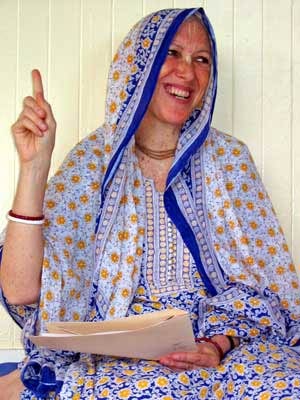A Successful Death: Hospice Nurse Shares Faith Experience
By Rita Gupta | Янв 03, 2009

In Krishna consciousness, life is a preparation for one moment — the moment of death. Devotees of Lord Krishna believe that whatever a person thinks about at that crucial moment determines the next destination of the soul. Therefore, they hope to think about Lord Krishna at the moment of death and thereby return to His home in the spiritual world.
Many devotees have passed away since the Krishna consciousness movement began in the west in 1965. Sangita Devi Dasi, a hospice nurse and co-founder of Vaisnavas C.A.R.E. (Counseling, Assistance, Resource, and Education for the Terminally ill and Their Families) has cared for many dying devotees. She describes what she refers to as a “successful death.”
“Just as a person prepares for a ‘successful birth’ when having a child, there is such a thing as a ‘successful death.’ When someone is as pain-free as possible given their diseased condition, has had time for closure with relationships and has reflected on various issues within one’s life, has been cared for by loving family and friends, and is surrounded by transcendental sound vibration such as the chanting of the Hare Krishna mantra, we consider one’s passing away to be a success and very auspicious.”
Sangita spoke about her godsister, Mula Prakriti Devi Dasi, who passed away within the holy area of Vrindavana in 2004. After losing touch for many years, Sangita received a call from Mula Prakriti’s husband, Gopavrindapala Dasa, asking if she would help him care for his wife in India. They had planned to meet in Vrindavana, but as it turned out, they all met in Amsterdam while changing planes. Mula Prakriti was very ill, and she slept during most of the flight. Sangita did have the opportunity to ask her, however, how a person prepares for death. After all, Mula Prakriti was a fairly young woman and was blessed with a beautiful, loving family. How does a person prepare to leave behind her husband of thirty years, three wonderful children, and her young grandchildren? Mula Prakriti kindly told her, “First, you read Bhagavad-gita. Then, you travel and tell the devotees what you are going through because they will have to go through this as well. Then you meditate and chant Krishna’s names. Then you read Bhagavad-gita again.”
When they finally arrived in India, a godsister had sent a taxi to meet them. The godsister had arranged for a bed in the back of the car so Mula Prakriti would be as comfortable as possible during the long ride to Vrindavana in the middle of the hot summer night. The next day, the devotees started coming to see Mula Prakriti. They showered their love on her by reading scripture and chanting for her every day. They even decorated Mula Prakriti’s room with pictures of Radha and Krishna. One godsister put a framed painting of their spiritual master, Srila Prabhupada, over the head of her bed. Sangita recalls, “That painting became the focal point of the room.”
Energized by the devotees, Mula Prakriti first rallied. For the first few days, she cared for herself. But soon, she became weak again. Sangita and the other devotees helped her to stay as comfortable as possible in the intense heat.
After two weeks, Mula Prakriti entered the “actively dying” stage. According to Sangita, most people go through this stage, regardless of their terminal disease. The person appears to be in a coma because he or she does not respond to speech and cannot make any movements to make their needs known. Just as evidence shows that those who have been in a comatose state can still hear, it is known that patients within this “actively dying” stage can also hear. Therefore, he or she is actually conscious, and can hear when someone speaks or chants. There is also the “death rattle,” when the breathing becomes moist. It often sounds as if the person is drowning.
The actively dying stage typically lasts 24-72 hours. Sangita commented, “It seems like a very long time for the caregivers and family to watch their loved one in this condition. At this time, devotees pray for Srila Prabhupada to come and take the soul back to the spiritual world.”
The devotees started telling Mula Prakriti, “Don’t worry. Prabhupada will come for you soon.” After some time, Sangita realized by Srila Prabhupada’s grace, that it was not for her to summon the Guru. When Srila Prabhupada was ready and he felt it was the proper time for his disciple, he would come for her. From that time forward, Sangita tells dying devotees, “When Srila Prabhupada is ready and you are ready, he will come. Be patient.”
Forty-two hours after she first entered the actively dying stage, Mula Prakriti Devi Dasi passed away. Sangita remembers, “I could perceive Srila Prabhupada’s presence in the room. It was as if he was reaching out his hand to his disciple and she was reaching out to him.” Then, Mula Prakriti’s lips quivered. As Padma Nabh Goswami, the priest from the Radha Raman temple in Vrindavana, told Sangita, when the lips quiver, it is usually an indication that the soul is leaving the body through the mouth. For devotees in the Krishna consciousness movement, this is considered an auspicious sign, and evidence that the soul is returning back to the spiritual world.
Sangita stated, “I have faith that Srila Prabhupada comes for his sincere disciples, granddisciples, and anyone who takes complete shelter of him.”
After caring for Mula Prakriti in her final days, Sangita now feels that she no longer fears dying. “This is the gift that was given to all of us by Srila Prabhupada,” she said. “By giving us Krishna consciousness, he has very mercifully given us the understanding to overcome our fears in this world and in the next.”















